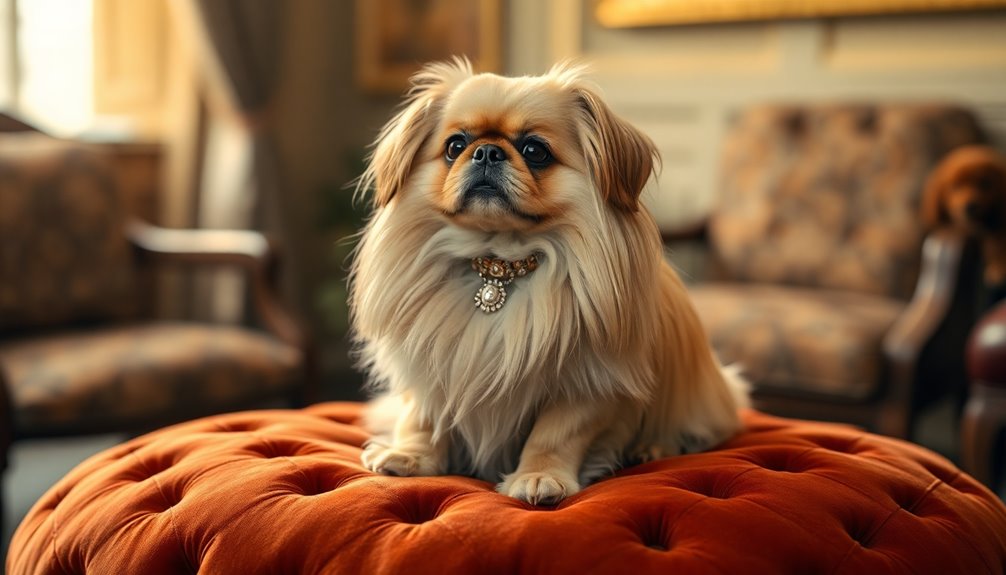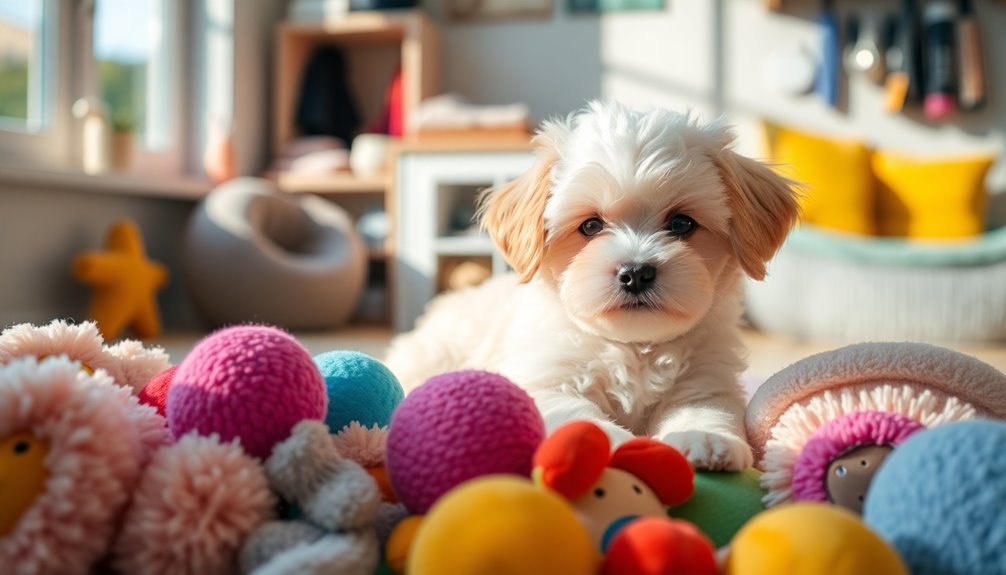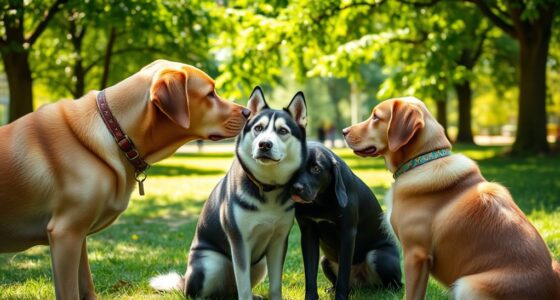To handle the regal nature of a Pekingese, you need to respect its noble lineage while establishing your role as the leader. Start by using positive reinforcement during training, as this breed can be stubborn. Early socialization is important for reducing anxiety and enhancing adaptability. Provide a comfortable living environment with cozy resting spaces, and engage in leisurely walks to meet their exercise needs. Regular grooming is also essential for their maintenance. By fostering a strong emotional bond through consistent interaction and training, you'll guarantee a happy and balanced companionship. Keep going to discover more significant tips and insights.
Key Takeaways
- Recognize their royal heritage and treat them with respect and dignity to foster a positive relationship.
- Use consistent training methods and positive reinforcement to manage their independent nature effectively.
- Provide engaging activities and mental stimulation to satisfy their need for stimulation and prevent boredom.
- Encourage socialization with various people and pets early on to help them adapt to different situations.
- Maintain a calm and confident demeanor during interactions to reinforce their sense of security and trust in you.
Understanding Pekingese History

The Pekingese breed boasts a fascinating history that traces back to ancient China, where these dogs were cherished companions of royalty. With their regal appearance, Pekingese became symbols of nobility and prestige, often seen at the side of emperors and empresses.
Stealing a Pekingese from the imperial court was no small offense; it was considered a serious crime, punishable by death, illustrating just how much value and status these dogs held in Chinese society.
As the Pekingese gained international recognition after the Opium Wars, they captivated audiences in the West, particularly when several were gifted to Queen Victoria. This royal endorsement further solidified their popularity beyond China's borders.
Historically, Pekingese are also linked to Buddhist monks, believed to bring good fortune. Their unique appearance led to their nickname, "Lion Dogs," reflecting their majestic stature.
The rich history and cultural significance of the Pekingese are evident in various art and literature references, ensuring their enduring popularity. Additionally, the breed's connection to social media scrutiny reveals how public perception can impact the reputation of even the most noble companions.
Understanding this background helps you appreciate the regal nature of your Pekingese, enriching your bond with this noble breed.
Unique Temperament Traits
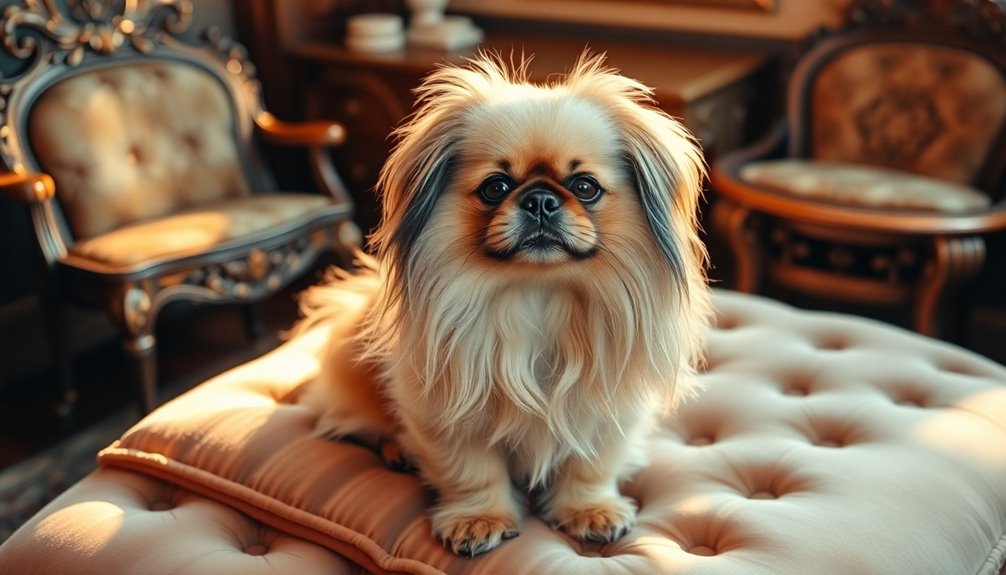
When you bring a Pekingese into your home, you'll quickly notice their independent streak and confident personality.
These little dogs form strong bonds with their owners, showcasing unwavering loyalty while often being cautious around newcomers.
Their boldness makes them surprisingly effective watchdogs, always alert and ready to protect their loved ones.
Independent Streak
Have you ever noticed how Pekingese can be both charming and challenging at the same time? Their independent streak often comes into play during training, making it essential for you to approach lessons with patience and consistency.
These little dogs are known for their stubbornness, which can lead to a bit of a power struggle if you're not careful. To overcome this, engage in training methods that utilize positive reinforcement. Rewarding good behavior with treats or praise can help you establish a cooperative relationship, encouraging your Pekingese to listen more willingly.
Remember, they respond best when they feel valued and respected. Early socialization is also key, as it helps your Pekingese adapt to different environments and reduces anxiety in new situations. Additionally, understanding their bold temperament can aid in managing their responses to perceived threats.
They may be aloof with strangers, but with your guidance, they can learn to be more comfortable. Their bold temperament often leads them to bark at perceived threats, so a strong foundation in training will help manage this behavior.
Loyal Companionship
Pekingese are truly remarkable companions, known for their unwavering loyalty and unique temperament traits. They form strong bonds with you, displaying affection that can turn into separation anxiety if you leave them alone for too long. Their regal demeanor often makes them reserved around strangers, but their fierce loyalty towards their family is unmatched.
To cultivate this loyal companionship, you'll want to focus on training sessions and proper socialization. Early exposure to various environments and regular interactions with people and pets will help your Pekingese develop well-rounded behavior. Here's a quick overview of key aspects to keep in mind:
| Aspect | Importance | Tips |
|---|---|---|
| Training Sessions | Foster obedience | Use positive reinforcement |
| Proper Socialization | Prevent fearfulness | Introduce new environments |
| Regular Interactions | Strengthen bonds | Schedule playdates and outings |
Bold Watchdog Behavior
Many owners are surprised by the boldness and courage displayed by these small dogs. Despite their size, Pekingese make effective watchdogs, alerting you to any unusual occurrences with their moderate barking. Their royal history has instilled a sense of dignity and assertiveness, making them both fiercely protective and loyal.
However, be aware that they can sometimes be aloof, reacting with vigilance toward strangers. To harness this bold watchdog behavior, early socialization is vital. Introducing your Pekingese to various people and pets can help mitigate any wariness they may have. This way, their watchdog instincts can be refined into more manageable behaviors.
Remember, Pekingese have independent spirits and can be quite stubborn. That's why consistent training strategies using positive reinforcement are essential. With patience and dedication, you can guide your Pekingese to become a vigilant, yet well-mannered watchdog.
Embrace their natural instincts while providing structure through training, and you'll find that their protective nature becomes a valuable asset in your home. Ultimately, their boldness and loyalty will shine through, making them a beloved companion and an effective guardian.
Creating a Comfortable Environment

To create a comfortable environment for your Pekingese, start by controlling the temperature to keep it cool and well-ventilated.
Make sure they've a safe, cozy resting space where they can feel secure and relaxed.
This setup not only caters to their physical needs but also respects their dignified nature.
Temperature Control Measures
Creating a comfortable environment for your Pekingese involves maintaining a stable indoor temperature, as these dogs thrive in cooler settings.
It's crucial to keep indoor temperatures between 65°F to 75°F (18°C to 24°C) to prevent overheating, especially during warmer months. Since Pekingese have brachycephalic features, they can struggle to breathe in high heat, making temperature control measures critical.
To keep your Pekingese comfortable, provide shaded areas and guarantee access to air conditioning or fans. Regularly monitor your dog for signs of overheating, like excessive panting or lethargy, as these indicate that immediate action is needed.
During extreme heat, limit outdoor activities to cooler parts of the day and opt for shorter walks.
In colder months, remember that Pekingese can also be sensitive to drafts. Ensure they've a warm, cozy space to retreat to when temperatures drop.
Safe Resting Spaces
A serene resting space is essential for your Pekingese's well-being. To create a comfortable environment, guarantee their resting spaces are cool, free from drafts, and away from extreme temperatures. A cozy bed or soft cushion placed in a quiet area acts as a safe retreat, allowing them to relax and feel secure. Additionally, ensuring their environment is free from digital distractions can help them maintain a peaceful state.
Here's how to set up the perfect resting space for your Pekingese:
| Element | Recommendation |
|---|---|
| Bedding | Soft, comfortable, and clean |
| Location | Quiet, elevated, away from foot traffic |
| Space | Clutter-free to minimize accidents |
| Maintenance | Regularly check for cleanliness |
Essential Diet and Nutrition

When it comes to feeding your Pekingese, ensuring a balanced diet is vital for their health and well-being. Aim for high-quality proteins and essential fats in their meals. You should provide daily portions ranging from 0.5 to 1.0 cups, divided into two meals to prevent obesity.
Since Pekingese are prone to obesity-related health issues, keep treats to no more than 10% of their daily caloric intake. Given their sensitive stomachs, it's important to select dog food that's easy to digest. Avoid giving them table scraps, as these can expose them to toxic foods.
Always make sure fresh water is available for hydration, with an approximate intake of 6 ounces per 7 pounds of body weight. Regular vet check-ups are also important. These visits help monitor your dog's health and allow for dietary adjustments based on specific concerns, such as allergies or sensitivities.
Training Techniques for Success

When training your Pekingese, focus on positive reinforcement strategies to keep them engaged and motivated.
Consistency is key, so use the same commands and methods to help them grasp what you expect.
Positive Reinforcement Strategies
Pekingese's unique personalities make training an exciting challenge, and positive reinforcement is the key to success. To effectively train your Pekingese, reward them with treats or praise immediately after they follow a command. This technique enhances their motivation and encourages compliance with training expectations.
Incorporate engaging training games that stimulate their intelligence, as they may learn a new command after roughly 100 repetitions. Keeping sessions fun and rewarding helps maintain their interest.
Be patient and consistent, as Pekingese are known for their stubbornness. It might take time for them to fully grasp and obey commands, so don't rush the process. Implement short, frequent training sessions of about 5-10 minutes to prevent fatigue and keep your Pekingese focused. Their attention spans can be limited, so shorter bursts of training are more effective.
Lastly, socialize your Pekingese early with various people and pets using positive reinforcement. This promotes well-rounded behavior and reduces any wariness towards strangers, enhancing their adaptability in different environments.
Consistent Command Training
Consistent command training is essential for ensuring your Pekingese learns effectively and responds to commands. Given their independent nature, it's important to exercise patience and persistence. Use positive reinforcement techniques, such as treats and praise, to motivate your Pekingese and keep them engaged. Training sessions should be short and enjoyable, ideally lasting about 5-10 minutes. This approach helps maintain their interest and reduces frustration.
Incorporating interactive training games can stimulate their intelligence and improve obedience, similar to how educational toys promote cognitive growth in children. Remember, Pekingese typically need around 100 repetitions to learn a new command, so consistency is key.
Here's a quick reference table for effective training techniques:
| Training Technique | Description |
|---|---|
| Positive Reinforcement | Use treats and praise to reward good behavior. |
| Short Sessions | Keep training sessions to 5-10 minutes. |
| Interactive Games | Engage their minds with fun training games. |
| Repetition | Expect to repeat commands about 100 times. |
| Early Socialization | Introduce them to new environments early on. |
Socialization Strategies
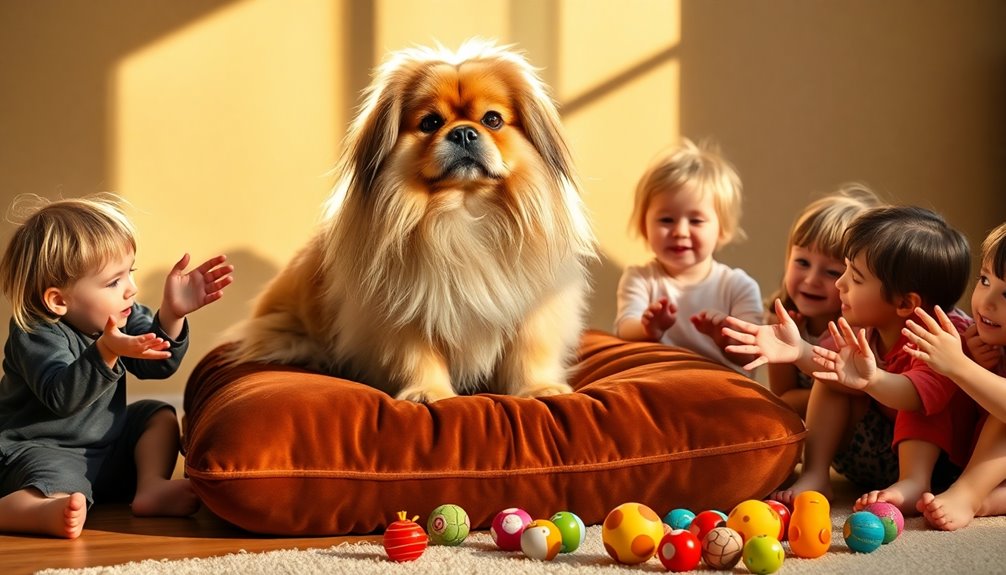
Socializing a Pekingese early on can make a significant difference in their behavior as they grow. Start this process when they're still a puppy, allowing them to adapt to various environments and become well-rounded adults. Gradually introduce your Pekingese to different people, pets, and situations. Using positive reinforcement, you can create positive associations, helping to reduce their wariness toward strangers.
Engage in regular playdates with other dogs and supervised interactions with children. This early exposure promotes friendliness and prevents aggressive or fearful behaviors. Remember, your Pekingese has an independent nature, so utilize gentle and consistent training methods that incorporate socialization without overwhelming them.
Monitor your Pekingese's body language during these sessions. Respect their boundaries to guarantee they feel comfortable; this is key to preventing anxiety and defensive behavior. By creating a safe and encouraging environment, you'll help your Pekingese thrive socially.
Consistent practice and patience are essential. The more positively you expose them to new experiences, the more confident and sociable they'll become. So, get started and watch your regal companion flourish!
Grooming and Maintenance Tips
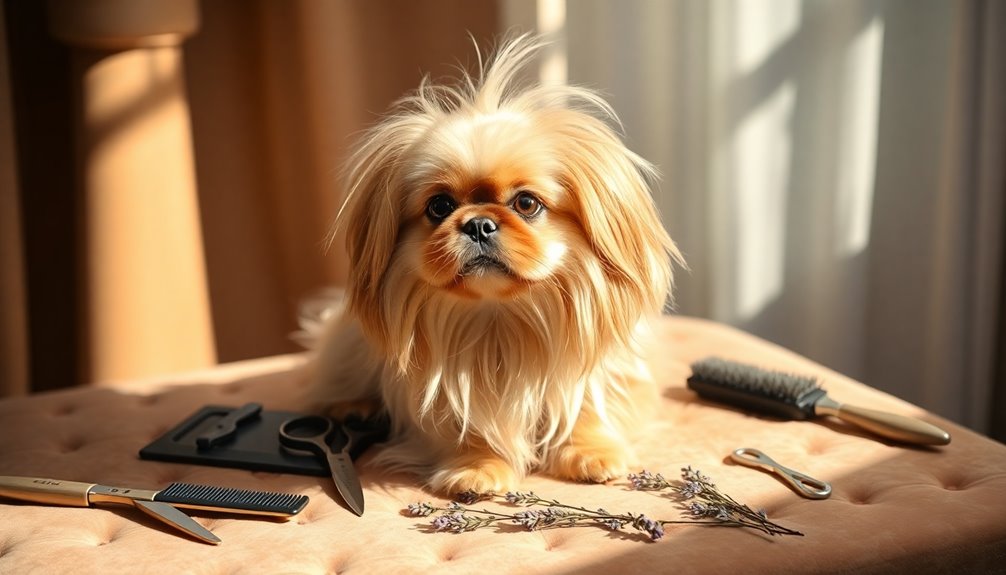
Maintaining the beauty and health of your Pekingese requires a commitment to regular grooming. Start with daily brushing to keep their long, flowing double coat free from mats and to effectively manage shedding. This daily routine will make a significant difference in your dog's coat health.
Bathing should occur every 4-6 weeks, focusing on cleaning those adorable facial wrinkles and skin folds to help prevent infections. If you find nail trimming challenging, consider scheduling professional grooming sessions periodically to keep your Pekingese's nails and coat in top shape.
Daily dental care is essential, so aim to brush your dog's teeth ideally every day or at least 2-3 times a week, using dog-specific toothpaste to ward off periodontal disease.
Don't forget to monitor and clean your Pekingese's eyes regularly. Their breed is prone to eye-related issues, so managing discharge is important to preventing conditions like corneal ulcers and dry eye.
Common Health Issues

While Pekingese are known for their charming personalities and distinctive appearance, they come with a set of common health issues that you should be aware of.
These regal pups are prone to brachycephalic airway syndrome (BOAS), which can cause breathing difficulties, especially in hot or humid weather. Their flat faces make it important to monitor their breathing closely.
In addition to respiratory concerns, Pekingese face other health challenges that require your attention:
- Eye issues: Conditions like corneal ulcers and dry eye demand regular vet visits.
- Skin health: Their facial wrinkles can lead to skin fold dermatitis, so consistent cleaning is essential to prevent infections.
- Joint problems: Hip dysplasia and patellar luxation may affect their mobility, requiring veterinary assessment.
Don't forget about dental care, either! Pekingese are susceptible to periodontal disease, so daily brushing is crucial for maintaining oral health. Regular visits to the vet can also help monitor for common health issues and catch any potential problems early.
Being proactive about these common health issues will help guarantee your Pekingese remains happy and healthy throughout their regal life.
Exercise Requirements
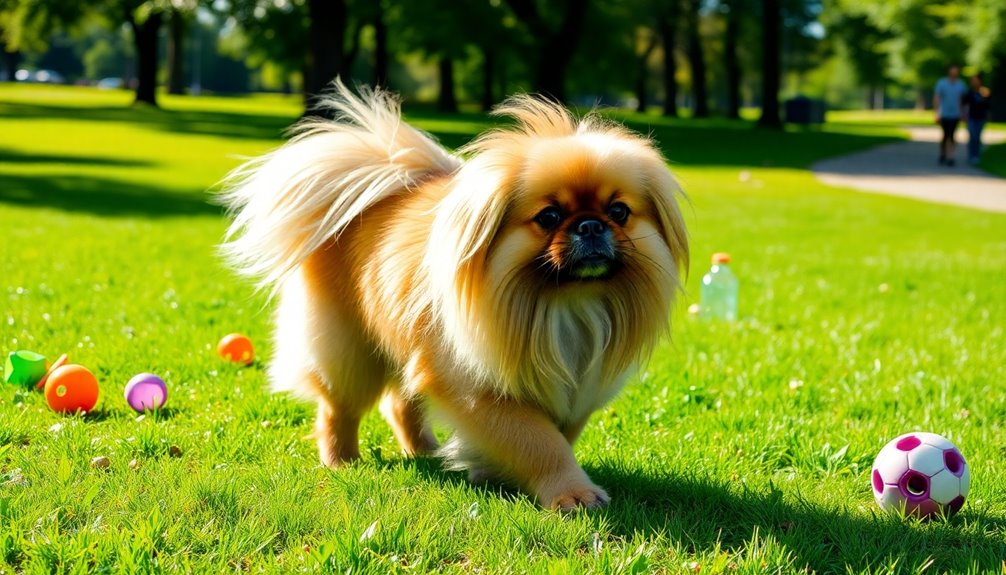
Understanding the health challenges Pekingese face is important, but so is knowing how to keep them active and happy. This small breed requires about 30 minutes to 1 hour of daily exercise, ideally split into two sessions. Given their brachycephalic nature, you'll want to avoid strenuous activities; light exercises like short walks are best for their comfort and health.
If you have a puppy, limit their exercise to 5 minutes for each month of age to prevent injury. Regular exercise not only helps maintain a healthy weight but also supports their mental stimulation, keeping boredom at bay and preventing behavioral issues. Additionally, incorporating interactive toys into their routine can further enhance their engagement and enjoyment during playtime.
Fortunately, Pekingese adapt well to apartment living, so moderate exercise is sufficient. They prefer leisurely strolls over vigorous activities, making it easy for you to fit their needs into your daily routine.
Aim for a balance of physical activity and mental engagement, like interactive toys or simple training sessions, to keep your Pekingese content. By providing the right amount of exercise, you'll guarantee your regal companion stays healthy, happy, and full of life.
Building a Strong Bond
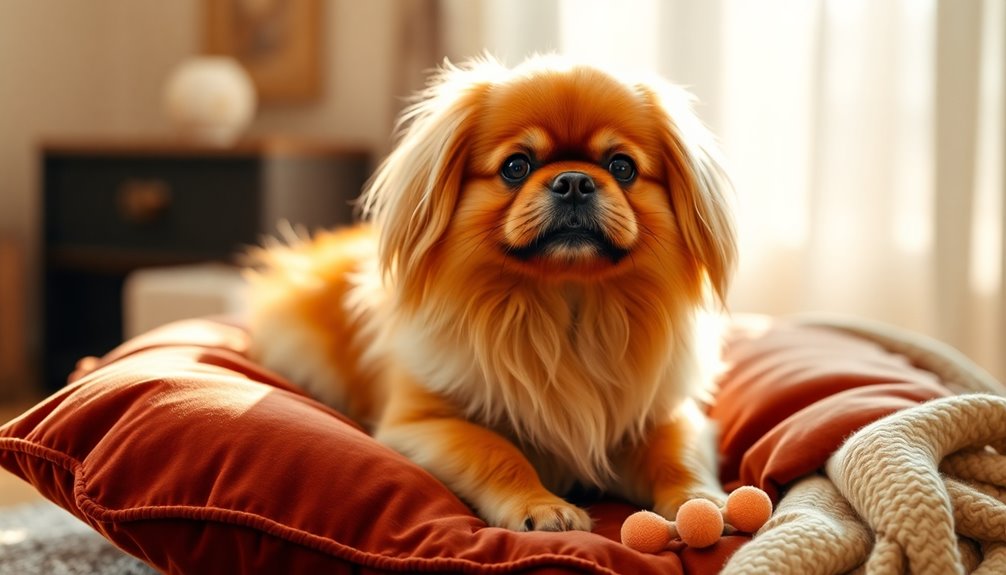
Building a strong bond with your Pekingese starts with consistent, positive reinforcement during training. These little regal companions respond far better to praise and rewards than to harsh discipline. Early socialization is essential; introducing your Pekingese to various people and pets helps them build confidence, which ultimately strengthens your relationship.
To deepen your connection, consider these engaging activities:
- Spend quality time grooming, as Pekingese love being pampered.
- Engage in interactive play, like puzzle games, to keep their minds sharp.
- Create a safe space where they feel secure and respected.
Recognizing your Pekingese's loyalty is key. Establish routines that include both training and play, allowing them to thrive emotionally. Additionally, incorporating educational toys can provide stimulating experiences that enhance their cognitive skills.
Always respect their boundaries, as this reinforces trust and affection. The more you share experiences together, the more your bond will grow. Incorporating positive reinforcement not only enhances their training but also enriches your relationship, making each moment spent together fulfilling.
Frequently Asked Questions
How Do You Discipline a Pekingese?
When you're disciplining a Pekingese, focus on positive reinforcement. Use treats and praise to encourage good behavior, as they respond best to rewards.
Be consistent with your commands and rules, so they understand what's expected. If they misbehave, gently redirect their attention or use a firm "no."
Keep training sessions short and engaging to maintain their interest, and remember, early socialization helps prevent behavioral issues down the line.
Do Pekingese Get Attached to One Person?
You walk into a room, and your Pekingese immediately perks up, eyes fixed on you like you're a celebrity.
Yes, Pekingese often get attached to one person, forming deep bonds that can be quite exclusive. They thrive on the attention you give and may follow you around, keeping a vigilant eye on your every move.
This loyalty is endearing but can lead to separation anxiety if you're gone for too long, so regular interaction's key.
How Do You Make Pekingese Happy?
To make your Pekingese happy, focus on daily mental stimulation with interactive toys and puzzle games that challenge their intelligence.
Regular grooming sessions not only keep their coat looking great but also strengthen your bond.
Offer short, leisurely walks and gentle playtime to satisfy their moderate exercise needs.
Create cozy resting spots for them to relax, and use positive reinforcement during training to build trust and make them feel valued in your family.
What Are the Behavior Problems of Pekingese Dogs?
Pekingese dogs can exhibit several behavior problems, including stubbornness, aggression, and excessive barking.
You might notice that they can be aloof around strangers or other pets if not socialized properly. Their regal nature may lead to wariness, making positive reinforcement essential for training.
Additionally, they often struggle with separation anxiety, so it's important to create a consistent routine and gradually expose them to new experiences to foster better behavior and confidence.
Conclusion
In the grand scheme of things, handling a Pekingese is all about embracing their regal nature and unique quirks. By understanding their history, temperament, and needs, you can create a loving, comfortable environment that fosters a strong bond. With the right training and grooming, you'll guarantee your furry companion thrives. Remember, the effort you put in will pay off in countless delightful moments together. So, roll up your sleeves and enjoy the journey with your royal pup!

